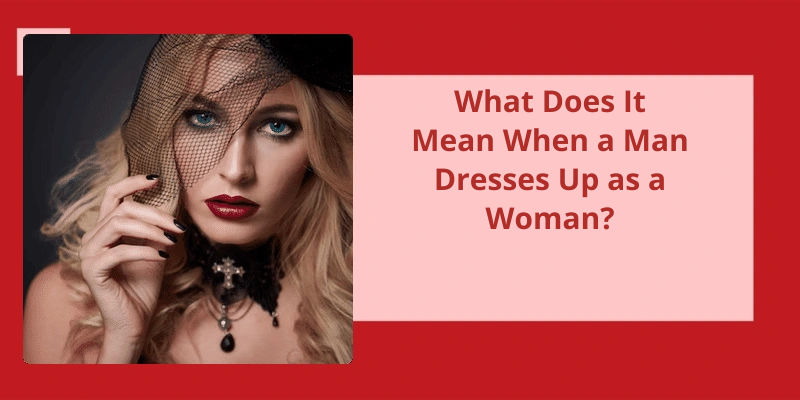However, in today's society, the act of cross-dressing is often associated with the LGBTQ+ community and the concept of gender identity. Specifically, when a man dresses up as a woman, it can be interpreted in multiple ways depending on the individual's intentions and personal beliefs. While some may view it as simply a form of self-expression or a way to explore their feminine side, others may see it as a political statement or an expression of their gender identity. Ultimately, the meaning behind a man dressing up as a woman is subjective and varies from person to person, and it’s important to approach the topic with an open mind and respect for individual differences.
Why Do Men Dress Up as Woman?
The act of cross-dressing, or dressing up as the opposite gender, has been a controversial topic that’s been the subject of much speculation and debate. While some people find it to be a harmless form of self-expression and creativity, others view it as a sign of deviance or even mental illness. Despite these opinions, cross-dressing has been around for centuries, and it continues to be a popular and prevalent phenomenon.
One of the main reasons men dress up as women is for sexual arousal. This behavior is often associated with fetishism, in which individuals derive sexual pleasure from certain objects or behaviors. For some men, the act of putting on womens clothing and assuming a feminine persona is an incredibly erotic experience. This arousal may be due in part to the taboo nature of the activity, as well as the association of femininity with sexuality.
However, not all men who cross-dress do so solely for sexual stimulation. There are other reasons why someone might choose to present as the opposite gender. For example, some people may cross-dress as a way to reduce anxiety or alleviate stress. Wearing womens clothing and makeup can provide a sense of comfort and relaxation, allowing individuals to escape from their everyday lives for a short period of time.
As societal norms continue to shift and evolve, it’s important to acknowledge and respect all forms of self-expression, even if they may not be fully understood.
The Differences Between Cross-Dressing for Gender Exploration and Cross-Dressing for Entertainment (Such as Drag Performances)
- Gender exploration cross-dressing is often done in private and is a personal and emotional journey of self-discovery.
- Entertainment cross-dressing is usually performed on stage as a way to entertain audiences and involves elaborate costumes and makeup.
- Gender exploration cross-dressing is typically not for the purpose of mockery or satire.
- Entertainment cross-dressing often involves the use of humor and satire to parody gender stereotypes and societal norms.
- Gender exploration cross-dressing is often done for therapeutic reasons and to better understand one’s own gender identity.
- Entertainment cross-dressing is performed for the purpose of entertainment and to push boundaries and challenge societal norms.
- Gender exploration cross-dressing is a personal journey and is often done in solitude or with trusted friends or partners.
- Entertainment cross-dressing is often done in front of a live audience and may involve professional drag performers.
- Gender exploration cross-dressing isn’t about conforming to gender norms, but rather about exploring and expressing one’s own identity.
- Entertainment cross-dressing often involves exaggerated gender expression and parody.
It’s clear that feminine clothes are essential to women’s fashion, but it’s not just limited to dresses and skirts. There are countless ways to incorporate feminine elements into your wardrobe and express your unique style. Whether it’s through color, texture, or accessories, the possibilities are endless. So, let’s explore what it truly means to wear feminine clothes and how to elevate your look with a touch of femininity.
What Is the Meaning of Feminine Clothes?
Feminine clothes are pieces of attire that are designed to showcase the beauty and elegance of a womans physique. These pieces are created exclusively for womens fashion to bring out the sensuality, delicacy, and charm of the fairer sex. Feminity is about showcasing grace, poise, and gentleness, qualities that are deeply ingrained within the female psyche, and are revealed through the clothes women wear.
Dresses and skirts are the most common and popular feminine clothes. Any style of dress or skirt can be selected to fulfil the objective of achieving the desired degree of femininity. Floor-length dresses are ideal for formal events and provide a regal appearance while knee-length and shorter dresses are perfect for informal outings and everyday use. Short and flirty skirts exude femininity and provide practicality and versatility for modern women.
Women who dress femininely possess an air of mystery and intrigue that draws people towards them. They provide women with an opportunity to unleash their inner goddess and feel confident, empowered, and beautiful.
The History of Feminine Clothing and How It Has Evolved Over Time
Feminine clothing has changed significantly throughout history. From ancient civilizations to modern times, styles and trends have shifted in response to cultural, social, and political changes. These changes reflect the evolving role of women in society and the increasing acceptance of gender diversity. Today, women have more fashion options than ever before, allowing them to express themselves in ways that were once unthinkable.
However, when a boy wants to dress like a girl, some parents may feel confused or apprehensive. It’s important to remember that this behavior doesn’t indicate anything about the child’s gender identity or sexual orientation. In fact, many children enjoy exploring different roles and identities through play. In the following sections, we will explore why boys may want to dress up like girls and how parents can support their child’s self-expression.
What Does It Mean When a Boy Wants to Dress Like a Girl?
It allows them to explore different roles and identities, which is a crucial part of their development. It also helps with their creativity and imagination as they come up with different scenarios and stories to act out. When a boy wants to dress like a girl, it could simply be because he likes the clothes or wants to try something new. It doesn’t necessarily mean that they’re transgender or have any sort of gender identity issues. It’s important not to read too much into it and just let them express themselves in a safe and supportive environment.
That being said, if a child consistently expresses a desire to dress up as the opposite gender or shows other signs of gender nonconformity, it’s important to listen to them and support them. Gender identity is a complex and personal experience, and we need to respect each persons individual journey. If a child is struggling with their gender identity, they may need additional support from a therapist or other mental health professional who specializes in working with children and adolescents. It’s important to remember that everyone deserves to be happy and comfortable in their own skin.
However, if there are deeper issues related to gender identity, we need to support and respect our childrens journey. We also need to be aware of the social and cultural context in which we live and work to create a more inclusive and accepting environment for all children. Ultimately, our goal should be to help our children feel happy and confident in who they’re and to support them in expressing themselves authentically.
Different Forms of Gender Expression and the Importance of Respecting Individual Choices
This topic explores the various ways individuals express their gender and emphasizes the need to respect each person’s unique choices. It highlights the diversity of gender identity and expression and advocates for inclusivity and acceptance.
Exploration of different roles and expressions during intimate moments can be a healthy and enjoyable experience for couples. While some may be curious about wearing clothing typically associated with the opposite gender, it’s important to remember that desires and fantasies are personal and can vary from person to person. It’s perfectly normal for individuals to explore and indulge in their unique preferences within a consenting and respectful partnership.
Is It Normal for a Man to Want to Wear Women’s Clothes?
However, when it comes to wanting to wear womens clothes outside of the bedroom, things become a bit more complicated. Society still carries a lot of stigma around gender and what’s considered appropriate clothing for men and women. Men who wear womens clothing in public can face discrimination, harassment, and even violence. This can make it difficult for men who enjoy wearing womens clothes to express themselves fully and openly.
It’s important to remember that wanting to wear womens clothes doesn’t mean that a man is gay or transgender. Gender expression and sexual orientation are two separate things and shouldn’t be conflated. Men who wear womens clothes may simply enjoy the aesthetic, the feel of the fabric, or the sense of freedom it brings them. It’s a personal choice that should be respected.
However, there are groups and communities online where men who enjoy wearing womens clothes can find support and understanding. These communities can provide a sense of belonging and a safe space for men to express themselves freely. It’s important to find allies and friends who accept and celebrate a mans choices, whether they involve wearing womens clothes or not.
The History and Cultural Significance of Gender-Nonconforming Clothing
Gender-nonconforming clothing has a rich history and cultural significance, dating back centuries and spanning cultures around the world. While specific styles and symbolism have varied over time and place, the act of wearing clothes that challenge traditional gender norms has long been a form of self-expression, resistance, and identity exploration for individuals across gender identities. From ancient Egyptian pharaohs to modern drag performers, gender-nonconforming clothing has played an important role in shaping our understanding of gender, sexuality, and personal freedom.
Source: Is it wrong for me to want to wear women clothing?..
Now that we’ve a general understanding of what it means to dress in a girly manner, it’s important to explore the complexities and nuances of this style. While some may view it as a simple expression of femininity, others may see it as limiting or even oppressive. In the following sections, we’ll delve deeper into the world of girly fashion and culture and examine it’s impact on individuals and society as a whole.
What Does It Mean to Dress Girly?
The term “girly” refers to a particular fashion sense that’s strongly associated with femininity. This type of dressing is often defined by frilly skirts, dresses, pastel colors, and floral prints. It may also be a way to feel more confident and self-assured in ones own skin.
For some, it can be seen as reinforcing gender roles and stereotypes, perpetuating the idea that women should be overly emotional and obsessed with their looks. However, it’s important to remember that individuals should be free to express themselves in any way they see fit, so long as it doesn’t harm others.
Many feminists are working to challenge traditional gender roles and the expected presentation of femininity. They’re fighting against societal pressures to conform to certain standards of beauty and behavior and to create a more inclusive, supportive, and tolerant society. Feminists often promote the idea of personal choice when it comes to fashion and beauty, encouraging women and girls to wear what they like and to express themselves in unique and individual ways.
The History of Girly Fashion and How It Has Evolved Over Time
This article explores the evolution of girly fashion throughout history, spanning different eras and styles. From Victorian dresses with corsets to the iconic flapper look of the 1920s, and from the bright colors and bold prints of the 1980s to the more subtle and sophisticated styles of the modern era, there have been many changes and variations over time. However, certain elements remain consistent, such as a focus on femininity, delicacy, and playfulness. The article also touches on societal influences and how they’ve impacted girly fashion throughout the years.
Conclusion
However, despite it’s long history, cross-dressing is still a topic that can be controversial and stigmatized in certain societies. Ultimately, the reasons why a man might choose to dress up as a woman are diverse and complex, and it’s important to approach the topic with empathy and open-mindedness.






